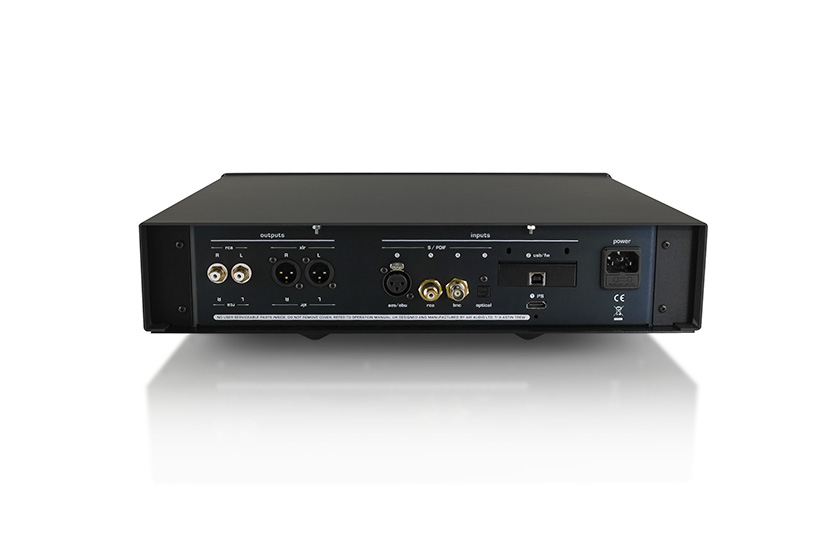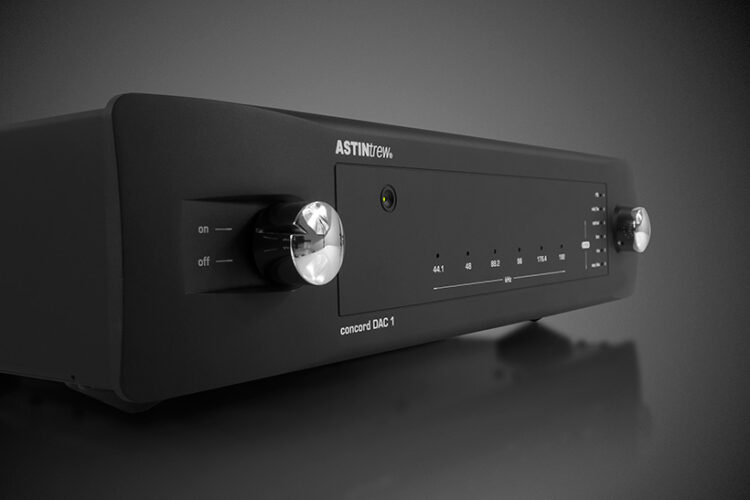The time must be right for music servers, streamers and D/A converters, I get one DAC or server after another, sometimes only for listening sometimes for reviews published in The Ear or in Dutch magazines. I love this kind of work and I find it very interesting to discover which paths manufacturers take. This time quite a costly DAC is on my bench, one with tubes in the output stage. The brand name Astintrew is not new and best known for more affordable, solid state electronics. The best Astintrew models are called Concord, represented here by the DAC 1.
The front looks typically British, it has knobs for power and input selection that’s all, but there is a row of green LED’s to indicate the sample rate of the incoming signal. On USB or Firewire there is one LED for each frequency, but strangely not for S/PDIF inputs. With standard material the LEDs 44.1 and 48 brightened, for any high resolution material all the LEDs shine green. On the back we find an I2S connection over HDMI dedicated to the forthcoming Concord drive, there are also inputs for RCA, BNC, Toslink, AES/EBU and a non-standard asynchronous USB bus. An optional card is available If you want Firewire instead of USB. The Concord accepts sample rates between 44.1 and 192kHz but is restricted to PCM, it’s not ready for DSD. The output follows the tube route for unbalanced out over RCA or a more traditional signal path with op-amps for the balanced out via XLR. Again a choice one would not expect. The actual conversion is done with a pair of Burr-Brown PCM1794 converters configured in dual mono mode. Investigating under the bonnet I notice a simple mains filter, 40.000µF buffering in the power supply, two transformers (one for the digital section, one for the analogue), six voltage regulators in total, Sylvania JAN 6922 signal tubes and Auricap XO output capacitors. The USB input is an industry standard XMOS-chip for which drivers are available on the ‘net. The construction of the casework mechanically decouples the printed circuit boards with special feet and silicone spacers. Apart from the optional Firewire or USB card, choices include a black or silver faceplate, silver, gold or black knobs and several different tube brand options. Also in the Concord line is an S/PDIF digital interlink and an active USB interlink with built-in power supply.

I connect the Astintrew Concord DAC 1 with a power cord made by Supra is connected to a Kemp Elektroniks Powersource, while Crystal Cables Ultra (RCA) and Van den Hul D-102 Mk III Hybrid (XLR) connect to my Strumento No.1 preamplifier. I carefully match the levels of both inputs on the preamp with those of my Esoteric DAC for an honest comparison. Source is a NAD M50 digital player and M52 music vault to feed both DACs on XLR using an Apogee Wyde-Eye cable, for RCA I use Stereovox XV2 (RCA->BNC). Of course I try USB later on; I will get to that for sure. The power amplifier is my Audia Flight 50 feeding PMC fact.12 loudspeakers. Some tweaks are in use, among them Acoustic System resonators and twenty recently applied Harmonix Big-Band tapes.
Life is all about making choices and with the Concord DAC 1 it’s no different. I can work with three different inputs, BNC (=RCA), AES/EBU and USB. The next option is to use one of the two outputs, solid state versus tube. These choices aren’t merely based on sound or sound quality but need to take into account which input/output is the best for the associated equipment. The output is not the easiest to decide on, through RCA the results are clearer while the sound stage is smaller. On XLR the stereo image reaches deeper into the background, but percussion for instance is not as ‘ticking’ as it could be. After a fair amount of comparison I can’t make up my mind so in the knowledge that most amplifiers only have RCA inpus I decide to stick with that one and take advantage of the output tubes. Next step is the choice between BNC or XLR digital input. Without a remote control option to switch inputs I have to walk back and forth to my rack a lot of times but finally decide to use XLR for the widest stereo image and the most natural sound. The stereo image reaches further back and gains in height and width. Most transports and digital players do not have a XLR digital out but one solution might be to use a Canare digital transformer in the signal path. Cables do make a difference as well and I am convinced that XLR out on the NAD M50 is the best to use on this NAD machine. Every D/A converter I have had at home with RCA and XLR inputs gave the better results on XLR.

XLRating
The Changing Lights by Stacey Kent is not only well recorded but also very nice to listen to. The title track puts a perfect voice in front of the band but not in your face, some distance is kept. Piano is not the DAC 1’s strongest point but percussion has enough power and is subtle with cymbals. Tom toms are fast and unrestricted and the bass offers the fundamentals. The stereo image shows how loudspeakers can disappear altogether and I get a rendition of the music in which nothing gets in the way of high quality overall sound. Music with a piano and cello from the CD Aventine by Agnes Obel fills the room with unearthly sound, I enjoy the way the instruments and voice in the mix depend on each other, I also realise that the definition of each instrument could be better. Another fine example of piano music is a recording by François Chaplin playing Nocturnes from Chopin. Solo piano captured on a high resolution 24bit/88.2kHz recording. A beautiful grand piano with a palette of harmonics is produced. With a really serious decoder the left hand notes flow all over the room, while those from the right hand are tightly bound to a centre space, the Concord does this but other converters distribute every note all over the stage.
Maybe it is because of the tubes in the output stage that the low end is not the best possible, let’s see how the converter behaves with other kinds of music. Moving from this great solo instrument to the electronic lounge sounds of Filur. Sound effects move into the corners of the room, reaching far beyond the loudspeakers, while bass bumps into my belly. The speakers are only two meters apart, to my ears it sounds like more than six, the full height of the room is in use and the back wall moves backwards. Some instruments seem to be next to me, which shows just how bit a soundstage is possible with the Concord. One of the best I have had at home so far.

In modern audio USB is the magic word so out comes my RipButler Linux based music server to be connected over AudioQuest Carbon USB cable to the DAC 1. It’s not an auspicious start however, Filur loses its magic. The stereo image gets much smaller, flat with less height, depth and width. Sounds that reached the side of the listening position before are now kept within a meter of the speakers. Stacey Kent with her The Changing Lights loses all the grandeur it had on the other inputs. Maybe I should have used the Astintrew active USB cable instead, at this moment I see no other option than to leave USB quickly. Not my cup of tea, not even taking into account the fiddling with drivers necessary under Windows. RipButler and DAC 1 need no special drivers, playing 24bit/192kHz files was no problem as soon as the two devices recognised each other. Again a side step, this time with the NAD M50, which has an I2S output over HDMI to match the Concord’s input. Unfortunately they’re not compatible with each other, that input is apparently reserved for the Concord transport. So I return to normal digital inputs and leave USB aside, and why not, Cantado by the Bobo Stenson Trio plays wonderfully on XLR in and RCA out, spatial and engaging especially on track two where the piano is in the lead, while bass and drums fight each other to get attention. Listen for yourself how beautifully the cymbals are balanced against the deep, bowed bass.
While enjoying this fine jazz music I find it time to come to some conclusions about the Astintrew Concord DAC 1. It has enough S/PDIF inputs for normal use and the extra I2S and Firewire or USB. The option to use the solid state output over XLR or the tube driven output over RCA makes it possible to fit the Concord into many different setups. I was most charmed using the XLR in and RCA out over extended periods. But take care with cables you use, they do make a difference. The retail price positions the DAC in the high end class and the competition is tough there. Competitors play at least in the same league and differ only in sound or features, each with its own capabilities or weaknesses. The strong points with the Concord DAC 1 are musicality and the imposing stereo image, it has speed, sounds nice, looks good and is flexible. This should be reason enough to put it on your short list.


